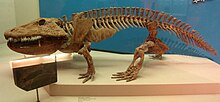引螈属
| 引螈属 | |
|---|---|

| |
| 大头引螈的骨骼模型与蝌蚪,美国国立自然历史博物馆 | |
| 科学分类 | |
| 界: | 动物界 Animalia |
| 门: | 脊索动物门 Chordata |
| 目: | †离片椎目 Temnospondyli |
| 科: | †引螈科 Eryopidae |
| 属: | †引螈属 Eryops Cope,1887 |
| 模式種 | |
| † 大头引螈 Eryops megacephalus Cope,1887
| |
引螈属(学名:Eryops,意为“延长的脸”,得名于其头骨大部分位于眼前),又称长脸螈,是一种已灭绝的离片椎目块椎类两栖动物。该属下仅一种大头引螈,化石主要发现于早二叠纪德克萨斯州及晚石炭纪新墨西哥州
描述[编辑]

引螈体长约1.5至2米,最长可达3米[1],是当时最大的陆地动物之一。成体体重可达102至222千克[2]。头骨大而长,宽而扁平,可达60厘米长,大嘴中具有弯曲的牙齿用于固定滑溜的猎物,具有牙釉质及迷齿类结构,表明了其咬住猎物向内吞下的捕食方法。[3]
古生物学[编辑]
引螈是早二叠纪最大的食肉动物之一,为半水生,但根据其骨组织解剖学分析,引螈并不高度水生,[4] 且不会常与合弓纲等竞争[5]。 引螈生活在低洼的水塘,溪流或河流中,其牙齿说明他们可能已大型鱼类或其他水生四足动物为食。[1]引螈僵硬的躯干和粗壮的尾巴说明他们可能不擅长游泳,成年引螈主要会在陆地上生活。
参考文献[编辑]
- ^ 1.0 1.1 Schoch, Rainer R. Evolution of life cycles in early amphibians. Annual Review of Earth and Planetary Sciences. 2009, 37 (1): 135–162. Bibcode:2009AREPS..37..135S. doi:10.1146/annurev.earth.031208.100113.
- ^ Hart, L.J.; Campione, N.E.; McCurry, M.R. On the estimation of body mass in temnospondyls: a case study using the large-bodied Eryops and Paracyclotosaurus. Palaeontology. 2022, 65 (6): e12629. doi:10.1111/pala.12629
 .
.
- ^ Rinehart, L. F.; Lucas, S. G. Tooth form and function in temnospondyl amphibians: relationship of shape to applied stress (PDF). New Mexico Museum of Natural History Bulletin. 2013, 61: 533–542 [2022-12-22]. (原始内容存档 (PDF)于2019-12-13).
- ^ Quémeneur, S.; de Buffrénil, V.; Laurin, M. Microanatomy of the amniote femur and inference of lifestyle in limbed vertebrates. Biological Journal of the Linnean Society. 2013, 109 (3): 644–655. doi:10.1111/bij.12066
 .
.
- ^ Van Valkenburgh, B.; Jenkins, I. Evolutionary patterns in the history of Permo-Triassic and Cenozoic synapsid predators. Paleontological Society Papers. 2002, 8: 267–288. doi:10.1017/S1089332600001121.












